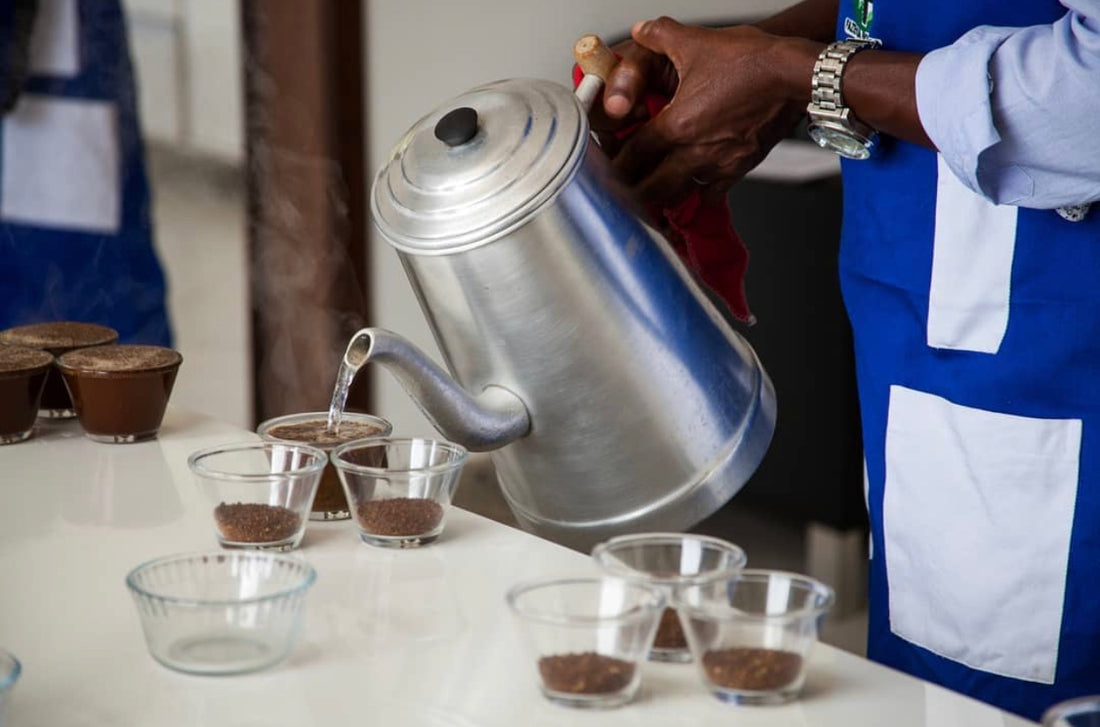==split_content==




==split_content==
Cupping is an industry quality control tool, and is just as fun as it is important. It’s when a range of coffees are tasted and assessed in a controlled environment.
You’ve probably heard “cupping” mentioned when talking to a coffee expert, or seen a “public cupping” event hosted at your local cafe. As the specialty coffee industry grows, so will the frequency of cuppings. This is because they are a crucial industry practice on all levels of the supply chain, and quizzically engaging to participate in.
Every specialty coffee is cupped at least three times before you taste it:
-
At Origin
The first time a coffee is cupped in its lifetime is the most exciting instance. It starts at origin, where producers roast the never-before tasted samples of their harvest. Origin-based graders will determine the value of their crop in this initial cupping. They base this decision on taste, yield, and demand before making the steps to put it on the market. This is the first time a coffee is tasted in its lifetime.
-
By the Green Buyer
The next cupping may occur when green buyers travel to origin, or when green samples are sent to buyers from the producer. Green samples are roasted and then cupped to determine if the buyer will purchase the coffee or not. This cupping can make the difference of a sale between the producer and the buyer.
-
At the Retail Level
Finally, cupping occurs on the consumer level: in cafes, roasteries, and anywhere someone has access to the right coffee and cupping utensils. The first person to perform this cupping is usually a roaster. They cup their roasted coffee to refine their own roast profiles, ultimately used for the final sale of coffee. This cupping determines if the coffee’s roast profile meets the standard to serve and/or sell. When a roast profile is finalised, the coffee goes on to being sold in a cafe or other retail environment for you to enjoy.
Cupping Mandatories
Roasted Fresh
The coffee must be roasted to industry standard. We keep within this parameter by using coffee roasted the day before the cupping. Coffee for cuppings is ideally roasted in a small-batch sample roaster for optimum quality control.
Ground Fresh
A coffee’s cupping grind setting is coarse: coarser than a pour-over and finer than a french press. It’s ground no longer than 15 minutes before being cupped. This ensures the coffee does not lose any flavour, and achieves its maximum potential bloom (CO₂ leaving the coffee).
Importance of Water
Water used in the cupping brew should be used at the ratio of about 18:1 water to coffee. This means that the vast majority of the coffee drink made is water, factoring in a huge importance on water quality. Check out the link above to see the industry standards of water quality. You can also stop by any Skittle Lane Cafe and ask for some of our filtered water optimised for coffee brewing.
Timing and accuracy
Precision is key to a fair cupping. Water volume measurement, a kettle, a scale to measure coffee weight, and a timer to time extraction are essential for accuracy. A coffee cupper needs to be exact down to the second when cupping a range of coffees to give each coffee standardised treatment. Think of it like an experiment: if one coffee is brewed with slightly hotter or more water than the others, the extraction may change causing a different outcome. That is why consistency must be controlled when cupping. Sometimes if there are many coffees being cupped at a time, there are multiple kettles and cuppers brewing in unison to achieve a standard. Remember: the outcome of a cupping could determine if an entire crop is sold or not.
Now that you know some more details on cupping, you’re probably interested in attending one. First, check if you are able to attend an event like a cupping, depending on your local guidelines because of the COVID pandemic. Many in-person cuppings have been cancelled due to social distancing, although they’ve sparked the rise in virtual cuppings, which can be held from anywhere with internet access and the means to share coffee. If you’re lucky to live in a place like Sydney, Australia, where Skittle Lane is based, there are currently eased COVID restrictions, so go ahead. We do not hold public cuppings at Skittle Lane, although there are many other cafes that do, or you can try it yourself at home with the right tools and coffee.
Cheers,
The Skittle Lane team.
Images via Melbourne Coffee Merchants
